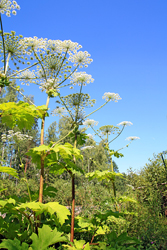Giant hogweed bites the dust
Reaching five metres in height, the giant hogweed (Heracleum mantegazzianum), produces toxic sap that can cause skin blistering and even blindness. It also outgrows and displaces native plants, damaging ecosystems and reducing the number of species they support. The invasive weed was originally introduced into European gardens as an ornamental plant in the 19th century and can now be found colonising waste land across the EU. The Giant alien project was set up to combat giant hogweed by developing an environmentally safe management strategy for controlling its spread. Emphasis was placed on developing sustainable strategies, perhaps making use of biological control methods and its natural competitors and enemies. Understanding the weed's biology and how it reproduces is crucial to successfully limiting or eradicating it. Researchers therefore investigated factors affecting the plant's ecology, biology, population characteristics and growth cycle. Botanical studies conducted in the Czech Republic and Germany showed that giant hogweed has a high seedling density and experiences low plant mortality combined with rapid population growth. Giant hogweed originally comes from the Caucasus where it favours, and is normally limited to, habitats disturbed by human activity. It can successfully self-pollinate and produces thousands of viable seeds which are then dispersed by wind, on the tyres of vehicles or attached to clothing or animal fur. The seedlings germinate in early spring before native species appear and rapidly increase in size and number, covering other species in dense shade winning the competition for light. Project partners developed best practice guidelines for local authorities and private landowners to control not only giant hogweed, but invasive alien weeds in general. The guidelines enable the weed to be identified and successfully eradicated, while preventing similar looking native plants from being misidentified and destroyed in error. Control of giant hogweed and other invasive plants protects vulnerable ecosystems and conserves native plant and animal species. The work of Giant alien will also help prevent injuries caused by contact with toxins produced by the weed.







